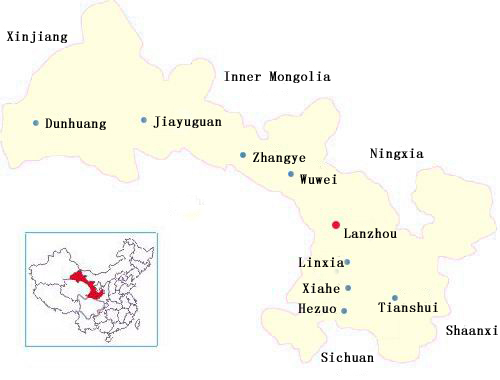| Living in Gansu |
| ・Gansu in Brief |
| ・Lanzhou in Brief |
| ・Places of Interest in Gansu |
| Location: Home>Living in Gansu>Gansu in Brief |
| Gansu in Brief |
|
|
Location Gansu is situated on the upper and middle reaches of the Yellow River in the northwest of China. The location of Fnaus is laos the junction of the three plateaus i.e. the Loess Plateau, the Inner Mongolian Plateau and he Qinghai-Tibetan Plateau. It has Shaanxi, Sichuan, Qinghai, Xinjiang Uygur Autonomous Region, the Inner Mongolian Autonomous Region and Ningxia Hui Autonomous Region as its neighbors.
Population Gansu Province covers an area of 425,000 square kilometers and has a population of over 26 million. With Lanzhou as its capital, Gansu has 14 municipalities and prefectures and 86 county-level cities under its jurisdiction. There are altogether 45 nationalities inhabiting here including Han, Hui, Manchu, Kazak, Yugu, Dongxiang and Bao’an nationalities. Among them, Yugu, Dongxiang and Bo’an can only be found in Gansu Province.
Geography As regards the physical feature, Gansu is long and narrow, looking likes a jade “Ruyi”—a jade mascot in China which symbolizes fortunate—on China’s map. It is descending from the southwest to the northeast. The highest peak of Gansu is Tuaanjie peak of Qilian Mountain with an altitude of 5808 meters above sea level and the lowest point is the bottom of Bailongjiang River valley with an altitude of 550 meters.
Climate With complicated and varied landforms, Gansu has mountains, valleys, prairies, plateaus, deserts and Gobi deserts. With temperature continental climate, most areas of Gansu Province are dry. Its annual rainfall is about 300 millimeters and defers greatly in different areas. The annual average temperature is between 4-14℃. Gansu has plenty of sunshine and strong radiation of all year and the temperature varies greatly form day to night.
Natural resources Gansu is richly endowed with natural resources. Within Gansu Province, over 140 kinds of mineral ores have been found. Among them, nickel, lead, zinc and platinum possess a significant position in China. Gansu is also one of the major producers of Chinese herb. Over 1500 kinds of crude drug grow here, ranking the second in China. Lily bulb, Chinese angelica, edible tree fungi and edible fiddlehead enjoy a good reputation both at home and abroad. Gansu Province is also home to over 800 wild animals including some rare animals like giant panda, golden monkey, musk deer and lynx etc.
Transporation In ancient times the Silk Road of Gansu played a great role in the economic and cultural exchanges between the west and China. Nowadays Gansu has already built a convenient transportation network of highway, railway and airway directing to the outside world.
Cited from: Gao Yafang & Qin Binfeng (2008). The Tour Guides’ Speech Collection About Gansu [M]. Beijing: China Travel and Tourism Press
|
